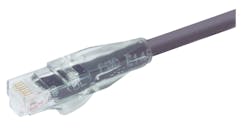Cabling: What’s Inside is What Matters
While Cat5e and Cat6 cables look exactly the same from the outside, it is what’s inside that makes the difference.
Selecting the best solution for a network system can seem like a daunting task. It is important to look at what is being used on the network today and try to figure out where your customer might be in 5 to 10 years. As a general rule, you should always be installing the latest technology (Category 6a) when building out an installation.
It is also critical to know your supplier and the component quality. Just because it says Category 6 or 6a does not mean it really is. As you can see in the graphic, there is a real difference —it can impact network performance, especially at the higher bandwidth of today’s demanding users.
What Changed
Category 6 cable, commonly referred to as Cat 6, is a standardized cable for Gigabit Ethernet and other network physical layers that is backward compatible with the Category 5/5e standards. Cat 6 extended key parameters over Category 5e specifications — the most prominent difference being the frequency at which those key parameters are measured. Compared with Cat 5 and Cat 5e, Cat 6 features more stringent specifications for crosstalk and system noise. The cable standard provides performance of up to 250 MHz (as opposed to up to 100 MHz for Cat5e) and is suitable for 10BASE-T, 100BASE-TX (Fast Ethernet), 1000BASE-T/1000BASE-TX (Gigabit Ethernet) and 10GBASE-T (10-Gigabit Ethernet).
Category 6a cable, (or Augmented Category 6), is characterized to 500 MHz and has improved crosstalk characteristics, allowing 10GBASE-T to be run for the same distance as previous protocols. See the nearby chart for all the details.
The jump from 100 to 250 MHz, and subsequently 500 MHz, places a great deal of emphasis on component quality as well as installation techniques. There are many factors that cable and component manufacturers must take into account when designing category rated products. With the development of Category 6 (and again with Category 6a), there were several key parameters that changed. Most notably, the insertion loss (sometimes called attenuation) and the pair to pair cross talk limits.
Each manufacturer used different techniques to achieve the required results, but here are a few of the basics:
- Pair twist rate: Improved noise cancellation can be achieved through better control of pair twisting. That is why it is critical that installers are careful when working with the individual pairs and should not unravel the twists.
- Pair Stagger: Having two pairs that are twisted identically will sometimes result in areas where two conductors actually run parallel to each other. This will result in signal degradation across pairs.
- Improved Materials: Better copper and insulation/jacketing compounds make for lower insertion loss (attenuation).
By improving pair twisting and stagger, performance is greatly enhanced. Cat6 cabling provides lower crosstalk and a higher signal-to-noise ratio than Cat5e cabling, and it is capable of supporting 10 Gbps speeds (up to 30m) in some cases. For most 10/100/1000 Ethernet networks, Cat5e cable is sufficient for speeds up to 1 Gbps; however, if your customer requires higher speeds and need to remedy crosstalk issues, Cat6 is your best bet. It is important to note that a Category 5e cable advertised as 350 MHz will not pass Category 6 testing.
Drawbacks of Patch Cable
Having a properly installed channel (including the entire cabling run, patch cables and connecting hardware), will result in maximum performance. All components and materials must have the same category rating and have been tested to that rating. Having a multi-thousand-dollar system installed professionally can be completely defeated by adding a low-cost economy patch cable. I have seen cables marked Category 6a that did not even pass Category 5e testing. I have also seen installation techniques that directly impact the network performance.
The test limits are different between Category 5e, 6, and 6a. Marketers will sometimes take advantage of those that do not dig into the details. A 350MHz Category 5e rated patch cord will not pass a 250MHz Category 6 test. At 100MHz, a Category 6 cable has a 19.8dB limit vs. a Category 5e cable which has a limit of 22dB. These values are different enough to have a negative impact on your network.
The Cat5e standard has no values above 100MHz. Some marketers will interpret values and project them up to the 250MHz level. That is not an accurate method. The standard is what it is and can’t be changed. If you are looking for Category 6 performance, then quality Category 6 cabling and components are required.
David Gallagher is product manager for Ethernet cabling and fiber optic products for cabling manufacturer L-com. To request more info about the company, please visit www.securityinfowatch.com/10841325.
About the Author
David Gallagher
David Gallagher is product manager for Ethernet cabling and fiber optic products for cabling manufacturer L-com. To request more info about the company, visitwww.securityinfowatch.com/10841325.
